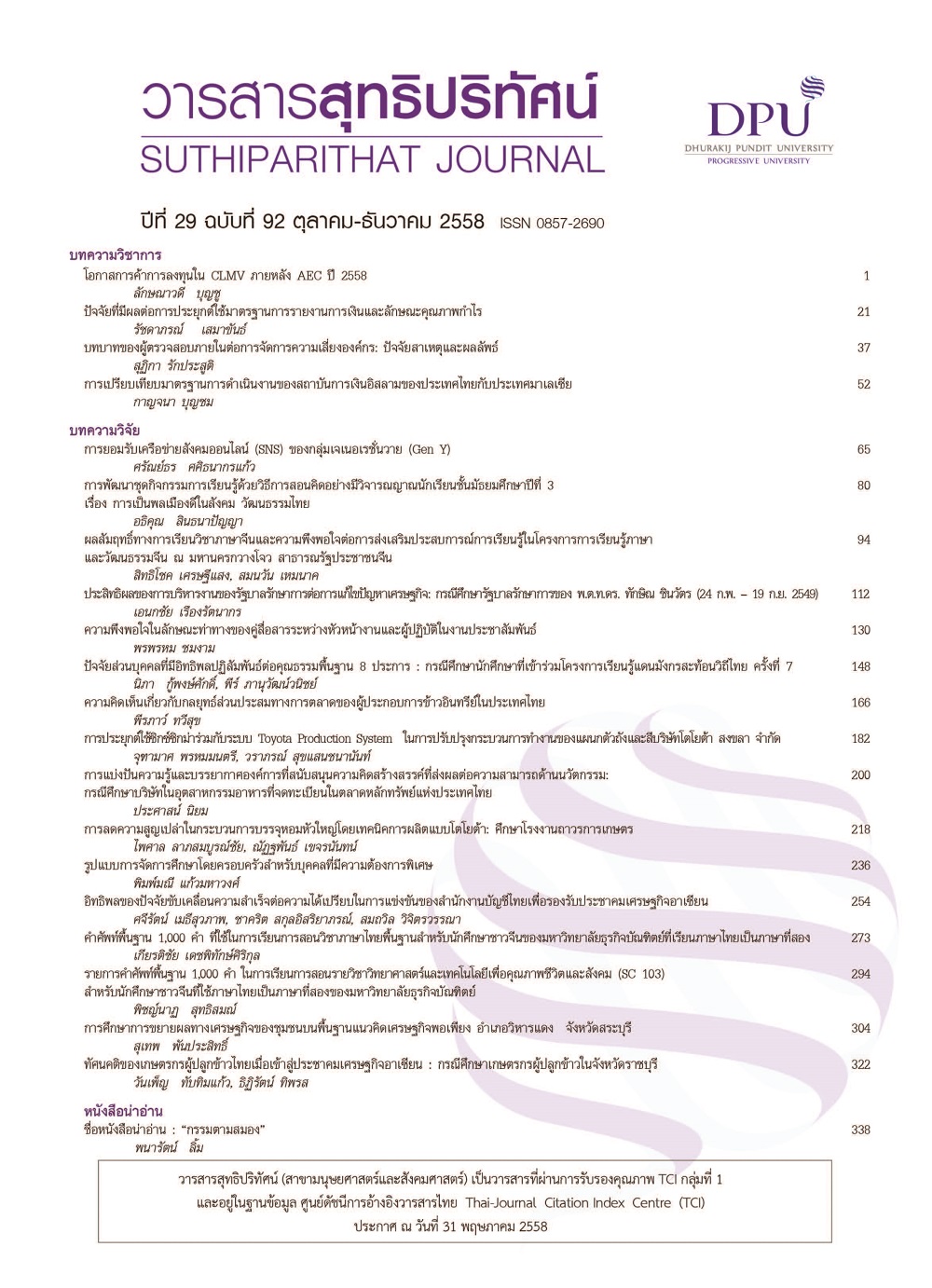บทบาทของผู้ตรวจสอบภายในต่อการจัดการความเสี่ยงองค์กร: ปัจจัยสาเหตุและผลลัพธ์
คำสำคัญ:
การควบคุมภายใน, การจัดการความเสี่ยงองค์กรบทคัดย่อ
บทความวิชาการเรื่องบทบาทของผู้ตรวจสอบภายในที่มีต่อการจัดการความเสี่ยงองค์กร มีวัตถุประสงค์เพื่อทบทวนวรรณกรรมเกี่ยวกับ 1) ปัจจัยสาเหตุที่มีผลต่อประสิทธิผลและมีประสิทธิภาพของการตรวจสอบภายในในด้านการจัดการความเสี่ยงองค์กร 2) ประโยชน์ของการจัดการความเสี่ยงองค์กรที่ส่งผลต่อมูลค่าเพิ่มขององค์กร
จากการทบทวนวรรณกรรมพบว่า ผู้ตรวจสอบภายในมีส่วนร่วมในการจัดการความเสี่ยงองค์กร และการจัดการความเสี่ยงองค์กรสร้างมูลค่าเพิ่มให้แก่องค์กร เช่น มูลค่าของกิจการเพิ่มขึ้น กิจการมีกำไรสูงขึ้น ลดความผันผวนของกำไร ค่าสอบบัญชีลดลง ตลอดจนลดการทุจริตในองค์กร สำหรับงานวิจัยในอนาคต นักวิจัยควรศึกษาปัจจัยที่ส่งผลกระทบต่อการปฏิบัติงานตรวจสอบภายใน ปัจจัยที่ส่งผลต่อความเป็นอิสระและความเที่ยงธรรมของผู้ตรวจสอบภายในและความสัมพันธ์ระหว่างคุณภาพการตรวจสอบภายใน การจัดการความเสี่ยงและผลการดำเนินงานของบริษัท ซึ่งคาดว่าการพัฒนาคุณภาพของการตรวจสอบภายในจะเป็นประโยชน์ต่อองค์กรอย่างแท้จริง
เอกสารอ้างอิง
Arena, M. & Azzone, G. (2009). Identifying Organizational Drivers of Internal Audit Effectiveness, International Journal of Auditing. 44, 43-60.
Ball, R. (2009). Market and Political/ Regulatory Perspectives on the Recent Accounting Scandals. Journal of Accounting Research. 47, 277-323.
Beasley, M. S., R. Clune & D. R. Hermanson. (2008). The impact of enterprise risk management on the internal audit function. Journal of Forensic Accounting. 9, 1-20.
Castanheira, N., Rodrigres, L.L. & Craig, R. (2010). Factors associated with the adoption of risk-based internal auditing. Managerial Auditing Journal. 25, 79-98.
Coleman, T.S. (2012). A Practical Guide to Risk Management (a summary). Research Foundation of CFA Institute. Retrieved August 20, 2014, from http://www.cfainstitute.org/learning/products/publications/contributed/Pages/a_practical_guide_to_risk_management__summary_.aspx
Coram, P., Ferguson ,C., & Moroney, R. (2008). Internal audit, alternative internal audit structures and the level of misappropriation of assets fraud, Accounting and Finance. 48, 543-559.
Desender, K. (2007). on The Determinants of Enterprise Risk Management. Retrieved August 20, 2014, from http://ssrn.com/abstract=1155218
Dionne, G. (2013). Risk management: History, definition and critique. Retrieved August 20, 2014, from http://ssrn.com/abstract=2231635 or http://dx.doi.org/10.2139/ssrn.2231635
George-Silviu, C. (2014). Analysis of Internal Audit Practices on FTSE100. Procedia Economics and Finance. 15, 1265–1272.
Hermanson, D. R., Ivancevich, D. M. & Ivancevich, S. H. (2008). Building an Effective Internal Audit Function: Learning from SOX Section 404 Reports. Review of Business. 28, 13-18.
Hoyt, E. R., & Liebenberg P. A. (2011). The Value of Enterprise Risk Management, Journal of Risk and Insurance. 78, 795-822
Munteanu, V. & Zaharia, D. L. (2014). Current Trends in Internal Audit. Procedia - Social and Behavioral Sciences. 116, 2239–2242.
Nocco, B. W., Stulz, & M. (2006). Enterprise risk management: theory and practice, Journal of Applied Corporate Finance. 18, 1-13.
Pagach, D. & Warr, R., (2010). The Effects of Enterprise Risk Management on Firm Performance. Retrieved August 20, 2014, from http://www.garp.orgmedia51855firm%20performance%20and%20the%20implementation%20of%20erm%20-%20
Ramamoorti, S. ( 2003). Chapter 1 Internal Auditing: History, Evolution, and Prospects 1. The Institute of Internal Auditors Research Foundation. Retrieved August 20, 2014, from
Sarens, G. (2009). Internal Auditing Research: Where are we going? Editorial. International Journal of Auditing. 13, 1-7.
Schneider, A. (2010). Analysis of professional standards and research findings to develop decision aids for reliance on internal auditing, Research in Accounting Regulation. 22, 96-106.
Smith, M. L., Michael S. D., & Michael., K. S.( 2009). Pivotal Change in US Public Policy: How the Sarbanes-Oxley Act Affected Internal Auditing and its Relationship to External Auditing. International Journal of Accounting,
Auditing and Performance Evaluation. Retrieved August 20, 2014, from http://ssrn.com/abstract=1455985.
Tamosiuniene, R. & Savcuk, O. (2007). Risk Management in Lithuanian Organizations Relation with Internal Audit and Financial Statement Quality. Theory and Practice. 5, 204-213.
The institute of internal auditors. (2004). The role of auditing in enterprise-wide risk management. Retrieved August 20, 2014, from www.theiia.org,https://na.theiia.orgstandardsguidancePublic%20DocumentsPP%20The%20Role%20of%20Internal%20Auditing%20in%20Enterprise%20Ri.
The Institute of Internal Auditors. (2013). International Standards for the Professional Practice of Internal Auditing The Institute of Internal Auditors. Retrieved August 20, 2014, from https://na.theiia.org/standards-guidance/mandatory-guidance/Pages/Standards.aspx.
ดาวน์โหลด
เผยแพร่แล้ว
รูปแบบการอ้างอิง
ฉบับ
ประเภทบทความ
สัญญาอนุญาต
เนื้อหาและข้อมูลในบทความที่ลงตีพิมพ์ในวารสารสุทธิปริทัศน์ ถือเป็นข้อคิดเห็นและความรับผิดชอบของผู้เขียนบทความโดยตรงซึ่งกองบรรณาธิการวารสาร ไม่จำเป็นต้องเห็นด้วย หรือร่วมรับผิดชอบใด ๆ
บทความ ข้อมูล เนื้อหา รูปภาพ ฯลฯ ที่ได้รับการตีพิมพ์ในวารสารสุทธิปริทัศน์ ถือเป็นลิขสิทธิ์ของวารสารสุทธิปริทัศน์หากบุคคลหรือหน่วยงานใดต้องการนำทั้งหมดหรือส่วนหนึ่งส่วนใดไปเผยแพร่ต่อหรือเพื่อกระทำการใด ๆ จะต้องได้รับอนุญาตเป็นลายลักษณ์อักษรจากวารสารสุทธิปริทัศน์ก่อนเท่านั้น







